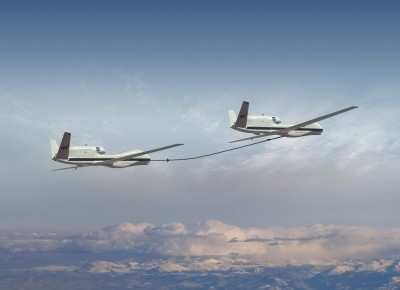Sun, Jul 04, 2010
Will Be The World's First Such Operation Between Two UAVs
DARPA has awarded a $33 million contract to Northrop Grumman
Corporation to demonstrate aerial refueling of a NASA Global Hawk
unmanned aerial vehicle (UAV) by a sister ship. The program will be
designated KQ-X. Northrop Grumman will retrofit two of the high
altitude long endurance (HALE) UAVs, one aircraft pumping fuel into
the other in flight through a hose-and-drogue refueling system. The
aerial refueling engagement will be completely autonomous.

Artist's Illustration
"Demonstrating the refueling of one UAV by another is a historic
milestone," said Carl Johnson, vice president, Advanced Concepts
for Northrop Grumman Aerospace Systems. "It adds aerial refueling
to the list of capabilities that can be accomplished autonomously
by Global Hawks; it opens the door to greatly expanded operational
utility for UAVs; and, as a side benefit, it promises to increase
the safety and reliability of aerial refueling between manned
aircraft by reducing pilot workload."
There are several revolutionary aspects to the KQ-X program. Not
only will the aerial refueling be autonomous, but since Global
Hawks are HALE UAVs, it will also take place at a much higher
altitude than has been previously demonstrated with manned
aircraft. It will also be the first time that HALE UAVs have flown
in formation. "The importance of aerial refueling is clear in the
way military aviation depends on it today," said Jim McCormick, the
DARPA program manager for KQ-X. "This demonstration will go a long
way towards making those same advantages a reality for the next
generation of unmanned aircraft."

Engineering work will be accomplished at the Northrop Grumman
Unmanned Systems Development Center in Rancho Bernardo, California.
Pilots from NASA, NOAA, and Northrop Grumman will fly the Global
Hawks from the NASA Dryden Flight Research Center at Edwards Air
Force Base, also in California. Sargent Fletcher, Inc. and Sierra
Nevada Corporation are major KQ-X subcontractors.
More News
Pilot Also Reported That Due To A Fuel Leak, The Auxiliary Fuel Tanks Were Not Used On June 4, 2025, at 13:41 eastern daylight time, a Piper PA-23, N2109P, was substantially damage>[...]
Have A Story That NEEDS To Be Featured On Aero-News? Here’s How To Submit A Story To Our Team Some of the greatest new stories ANN has ever covered have been submitted by our>[...]
From 2023 (YouTube Edition): Reflections on War’s Collective Lessons and Cyclical Nature The exigencies of war ought be colorblind. Inane social-constructs the likes of racis>[...]
Aero Linx: Colorado Pilots Association (CPA) Colorado Pilots Association was incorporated as a Colorado Nonprofit Corporation in 1972. It is a statewide organization with over 700 >[...]
High Speed Taxiway A long radius taxiway designed and provided with lighting or marking to define the path of aircraft, traveling at high speed (up to 60 knots), from the runway ce>[...]
 NTSB Prelim: Piper PA-23
NTSB Prelim: Piper PA-23 ANN FAQ: Submit a News Story!
ANN FAQ: Submit a News Story! Classic Aero-TV: One Mans Vietnam
Classic Aero-TV: One Mans Vietnam ANN's Daily Aero-Linx (07.03.25)
ANN's Daily Aero-Linx (07.03.25) ANN's Daily Aero-Term (07.03.25): High Speed Taxiway
ANN's Daily Aero-Term (07.03.25): High Speed Taxiway




